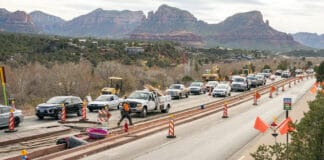If the tri-cities of Prescott, Prescott Valley and Chino Valley want to pump water from the Big Chino Aquifer near Paulden, they’ll have to provide assurance to the Salt River Project and environmentally concerned groups, such as the Center for Biological Diversity, that there will be no loss in Verde River flow.
By Todd Etshman
Larson Newspapers
If the tri-cities of Prescott, Prescott Valley and Chino Valley want to pump water from the Big Chino Aquifer near Paulden, they’ll have to provide assurance to the Salt River Project and environmentally concerned groups, such as the Center for Biological Diversity, that there will be no loss in Verde River flow.
Exactly when pumping would actually begin is unknown, but Michelle Harrington, of the Center for Biological Diversity, said Chino Valley officials believe they could start this summer.
“We want to work with these folks, but we would not let that happen and we would file an injunction to stop it,” Harrington said.
“Zero percent loss to the Verde River flow is what our shareholders in the [Phoenix] Valley want and have had for over 100 years,” SRP principal analyst Greg Kornrumph said from his office in Phoenix.
At the request of the three communities, SRP sent a letter to the city managers in mid-December stating their concerns regarding the proposed pumping of water from the Big Chino aquifer.
The Center for Biological Diversity provided the five-page letter to the Cottonwood Journal Extra, written by SRP associate general manager John Sullivan.
The letter outlines basic steps the communities must take to meet SRP expectations.
“Although we have heard your representatives say that the various pump projects will not impact the Verde River, we disagree,” Sullivan stated in the letter.
“Rather than debate whether or not impacts will occur, we believe your communities need to act quickly to develop and implement a scientifically sound monitoring program and an actionable mitigation plan to offset all water supply and environmental impacts should they occur,” Sullivan wrote.
Although the communities have acknowledged receiving the letter, they have yet to respond to it.
“All the communities have said we won’t hurt the river. For years, SRP has had discussions like this for when the day comes that they start pumping from the Big Chino Aquifer, but they’ve never resulted in a mitigation proposal,” Kornrumph said.
Kornrumph said the letter did not contain an all inclusive list of SRP concerns.
“It was intended to get this thing going. Let’s move forward with an actionable mitigation plan,” he said.
“Basically, they’re reiterating that they are the senior right-holder on the river,” Cottonwood Assistant City Manager Robert Hardy said.
Hardy is familiar with the current proposed pumping project as well as others through the years, and serves on regional committees such as the Yavapai Water Advocacy Group, concerned with the issue.
“A lot of people are watching this for different reasons,” Hardy said.
“If they’re going to do this, they must replace the water that they take,” Harrington said.
Among the ways Harrington said the water could be replaced are effluent detention and storm water conservation.
Both SRP and the Center for Biological Diversity want to see a water replacement plan before any pipeline is constructed in the Paulden area to carry Big Chino area water to Prescott area communities.
Any impact to the Verde River flow upstream could have consequences to Verde Valley communities.
“There will definitely be less water for you and you could see the riparian habitat dry up and the cottonwood trees die off,” Harrington said.
However, Hardy thinks it is unlikely Cottonwood’s cottonwoods would die from the proposed Big Chino Aquifer pumping.
U.S. Geological Survey studies show that the effect will be on springs downstream about 20 miles from the pump site, Hardy said.
“We’re considerably further than that. The river picks up and gains water before it gets here although there could be some vegetation and fish issues,” Hardy said.
The effect of the pumping could be especially severe during dry summer months when aquifers are the only source of water feeding the river.
“We’re concerned with the driest time of the year when there is no runoff,” Harrington said. “That’s when the aquifer water is most essential.”
Harrington said if and when pumping starts depends on what day of the week it is and what newspaper you read.
“Some of the obfuscation is coming from the communities, who think it won’t impact the river,” Harrington said. “But, it’s all hooey, it will impact
the river.”
Up to this point, the communities and special interest groups involved have worked cooperatively.
“It’s a very complex issue from a geological standpoint and it exacerbates the potential for additional development,” Hardy said. “But we’re all working together to find the right answer.”
Todd Etshman can be reached at 634-8551 or e-mail to tetshman@larsonnewspapers.com


















